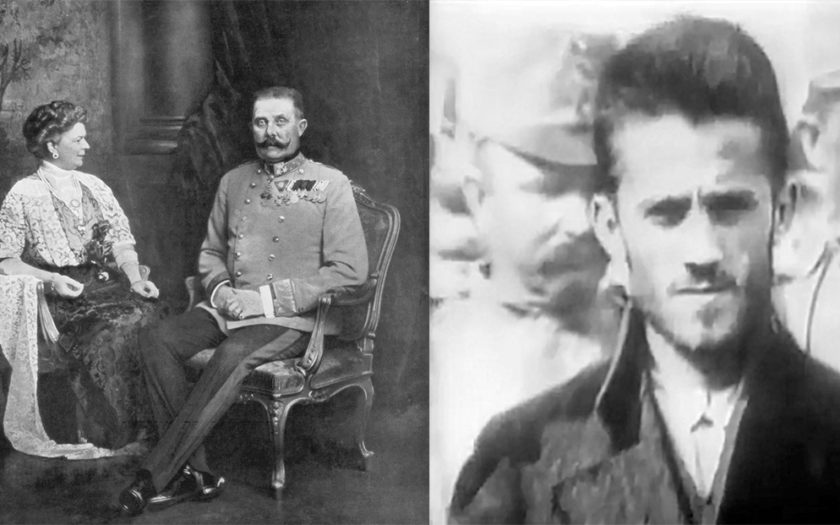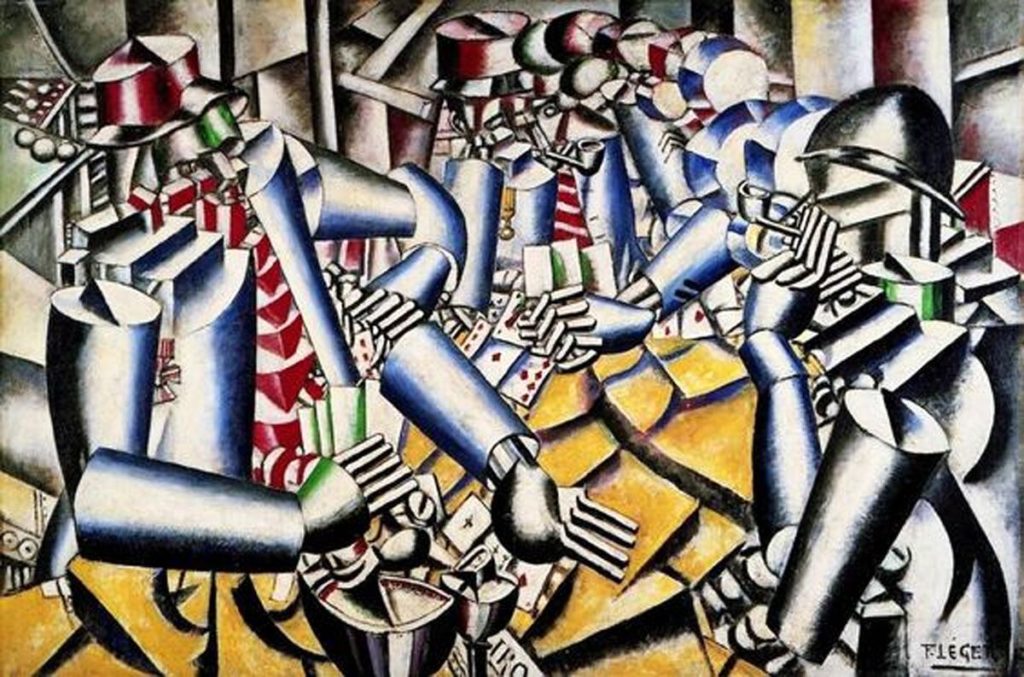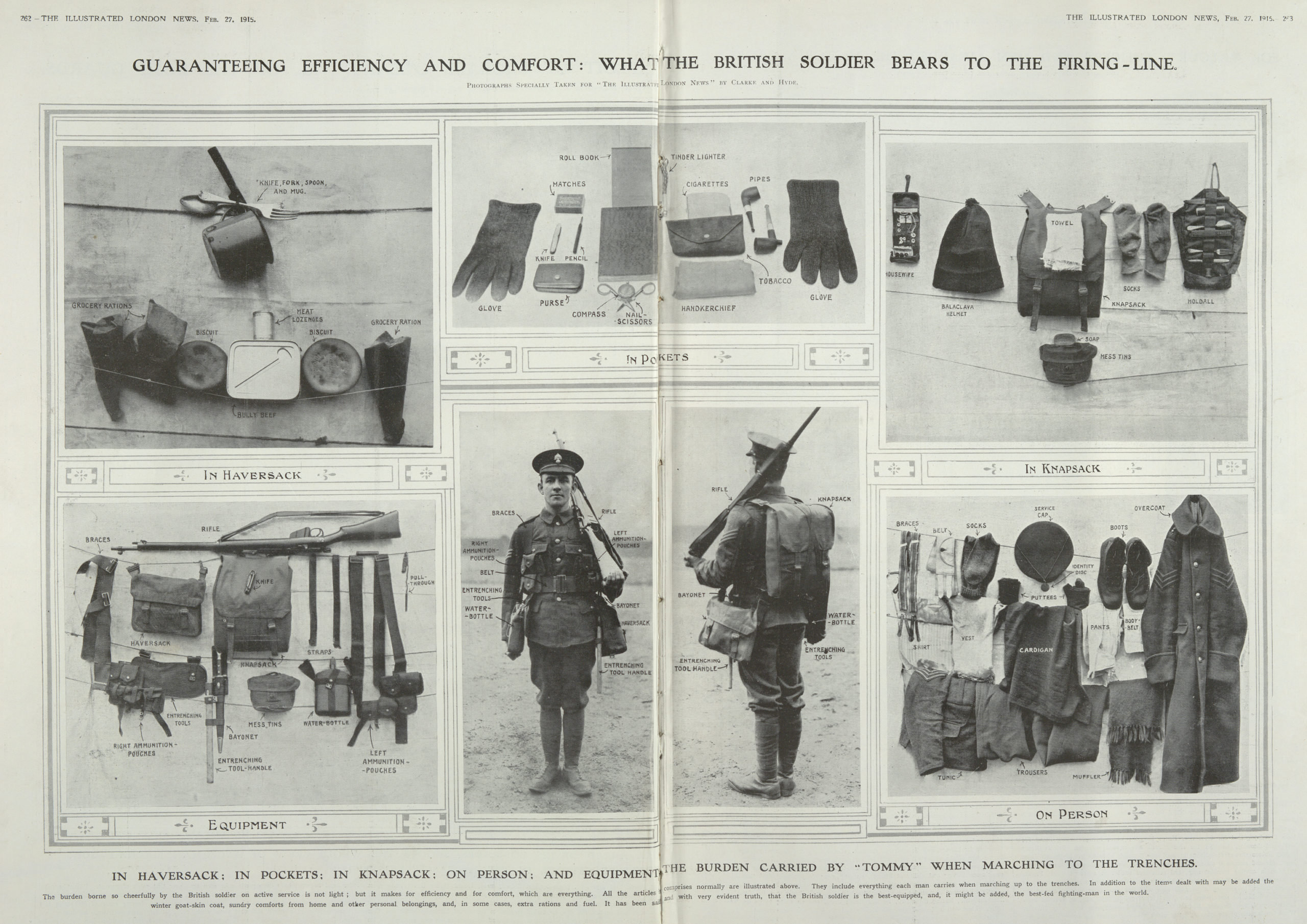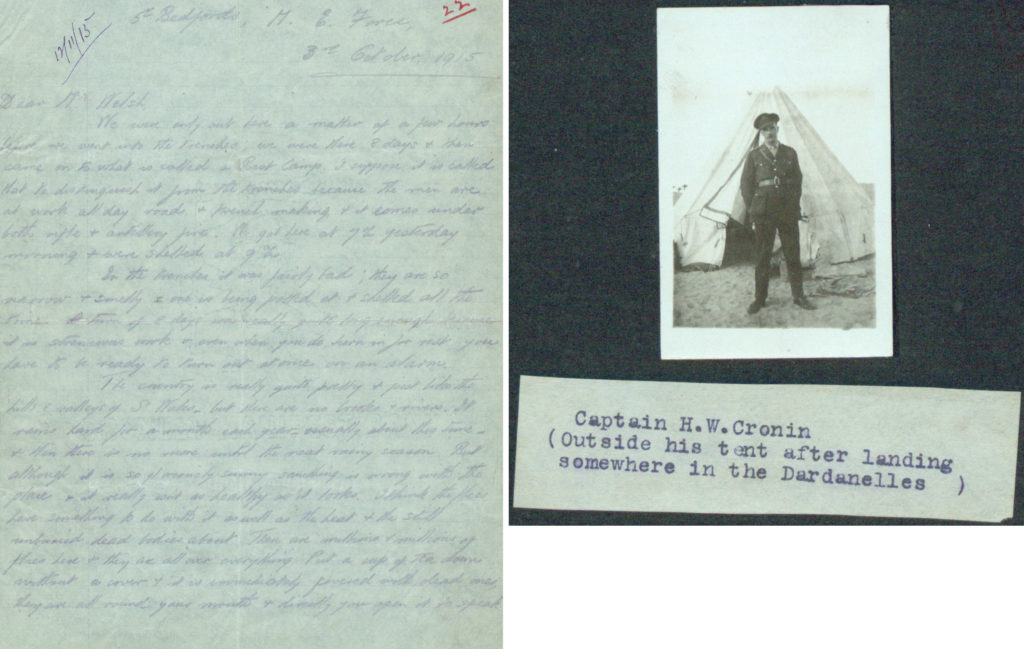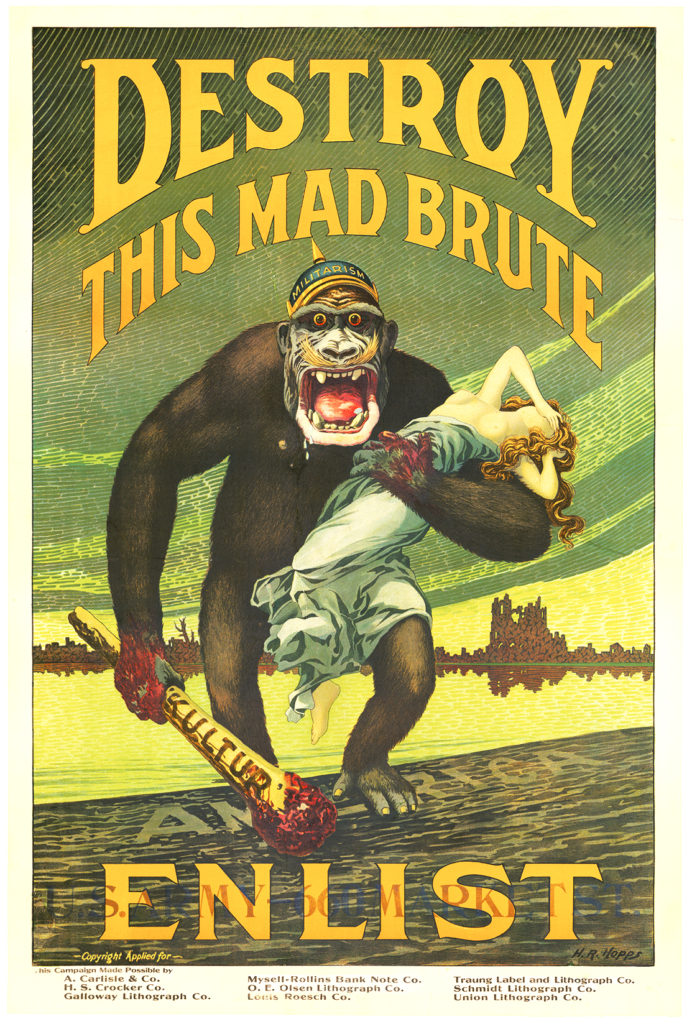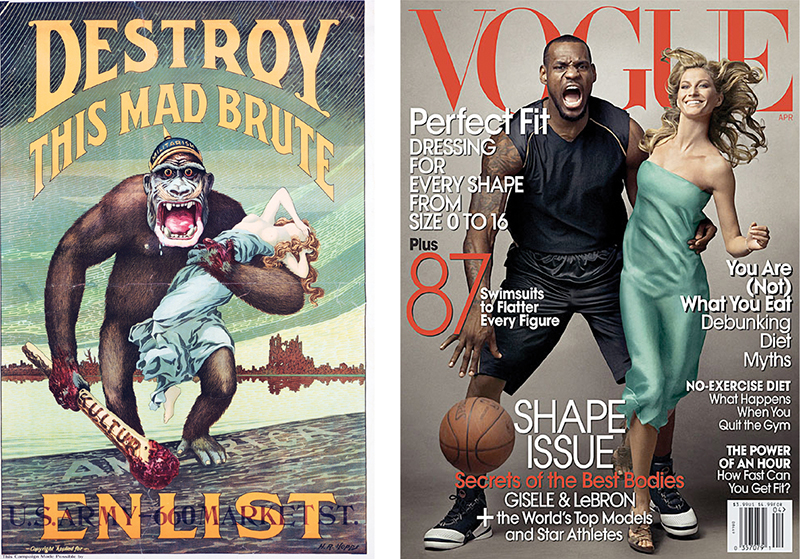Right: Sophie, Duchess of Hohenberg, Archduke Franz Ferdinand of Austria; Left: Gavrilo Princip, who assassinated them both on June 28, 1914, sparking World War I.
This week during World War I
June 28, 1914 — Gavrilo Princip lights a fuse, and the chain reaction immediately gets out of control.
Assignments
Podcast Lecture
Listen to two hours of Dan Carlin’s Hardcore History, “Blueprint for Armageddon,” Part I
Please consider purchasing Dan Carlin’s Hardcore History, “Blueprint for Armageddon,” Part I directly from Dan Carlin.
Poetry
Joining the Colours
by Katharine Tynan
There they go marching all in step so gay!
Smooth-cheeked and golden, food for shells and guns.
Blithely they go as to a wedding day,
The mothers’ sons.
The drab street stares to see them row on row
On the high tram-tops, singing like the lark.
Too careless-gay for courage, singing they go
Into the dark.
With tin whistles, mouth-organs, any noise,
They pipe the way to glory and the grave;
Foolish and young, the gay and golden boys
Love cannot save.
High heart! High courage! The poor girls they kissed
Run with them : they shall kiss no more, alas!
Out of the mist they stepped-into the mist
Singing they pass.
Source: Westminster Gazette (1914)
Read about Katharine Tynan at The Poetry Foundation
Visual Art
“Tubism”
Fernand Léger, Soldiers Playing Cards, 1917, oil on canvas, Kröller-Müller State Museum, Ontario.
https://krollermuller.nl/en/fernand-leger-soldiers-playing-cards
https://krollermuller.nl/en/fernand-leger-soldiers-playing-cards
Joseph Fernand Henri Léger (French: [leʒe]; February 4, 1881 – August 17, 1955) was a French painter, sculptor, and filmmaker. In his early works he created a personal form of cubism (known as “tubism”) which he gradually modified into a more figurative, populist style. His boldly simplified treatment of modern subject matter has caused him to be regarded as a forerunner of pop art.
Wikipedia contributors, “Fernand Léger,” Wikipedia, The Free Encyclopedia,
https://en.wikipedia.org/w/index.php?title=Fernand_L%C3%A9ger&oldid=964585764 (accessed July 1, 2020).
Learn more about Léger at Wikipedia, which has an impressive collection of media related to Léger.
History
Studying historical documents and sources.
Description: ‘What the British soldier bears to the firing line’: a feature in the Illustrated London News, depicting the kit a soldier carried.
Source: The National Archives UK
Catalogue Reference: ZPER 34/146s9
Date: 1914- 1918
Questions to consider:
• Knowing that the items issued to the soldiers might be difficult or impossible to replace, which items would be most valuable to you?
• How might soldiers in the trenches replace daily necessary items despite failures of the supply chain?
History
Studying primary documents and sources — personal correspondence
Listen to a reading of a letter from Harold William Cronin; Source: The National Archives, UK.
Text of letter from Harold William Cronin
This is one of many letters sent by staff of the Great Western Railway Audit office at Paddington who had enlisted to fight in the First World War. Image shows part of letter. (RAIL 253/516)
Harold William Cronin, 3 October 1915, Dardanelles. Born: 9 May 1880, Regiment: 4th Seaforth Highlanders. Rank: Promoted to Lieutenant in 5th Bedfordshire Regiment on 20 May 1915, Died: 2 December 1917 in Palestine, leaving £268 19s to his widow Muriel
Dear Mr Welsh,
We were only out here a matter of a few hours before we went into the trenches; we were there for eight days and then came on to what is called a Rest Camp. I suppose it is called that to distinguish it from the trenches because the men are at work all day road and trench making and it comes under both rifle and artillery fire. We got here at 7 o’clock yesterday morning and were shelled at 9 o’clock.
In the trenches it was fairly bad, they are so narrow and smelly and one is being potted at and shelled all the time. A turn of eight days was really quite long enough because it is strenuous work and even when you do turn in for a rest you have to be ready to turn out at once on an alarm.
The country is really quite pretty and just like the hills and valleys of South Wales, but there are no brooks or rivers. It rains hard for a month each year usually about this time and then there is no more until the next rainy season. But although it is so gloriously sunny something is wrong with the place and it really isn’t as healthy as it looks. I think the flies have something to do with it as well as the heat and the still unburied dead bodies about. There are millions and millions of flies here and they are all over everything. Put a cup of tea down without a cover and it is immediately covered with dead ones, they are all round your mouth and directly you open it to speak or to eat in they pop. It is a game. We have all got nets of course, we should have been worried, no medicine by now if we hadn’t.
We get plenty of bully beef and army biscuits, but bread and fresh meat is still a luxury and it is not possible to buy anything. It must have been a “No Man’s Land” because there are no houses or buildings of any kind to be seen and except the flies, the only living things are green canaries and lizards.
We live in dugouts built up the reverse sides of the hills. They are just holes really, but all the same they can be made very comfortable with a bit of digging and a few waterproof sheets. They are not shell proof by any means and the one I slept in during my first night here was knocked in completely by a shell pitching right into it. Fortunately I was not at home at the time. We have another now and I must try and get a photo of it and let you see what it is like. I must send you one of our Mess dugout too.
Everything here is named after the Regiment responsible for the making or taking. For instance the road we made from our trenches to this camp is called “New Bedford Rd” and the ridge we took and now occupy is called on the army maps, Bedford Ridge. I have just been filling in and colouring my map and find it is one of the most, if not the most, advanced line of the lot. Standing on that ridge it is possible to see what a lot of country we have taken and now hold, but there is nothing to get wildly excited about. Each position is strengthened as much as possible before another attempt is made to push on and the whole thing is just steady progress. Something might happen suddenly, I only hope it does.
We have had some very big ships out here and they have been bombarding the forts heavily now for some few days, and there are cruisers, monitors etc. standing in the bay helping the land batteries to shell the trenches. You see a flash and then wait a long time before hearing the boom and the shriek of the shell passing over our heads, almost together, then look round quickly and see the burst of the shell in or over the trenches sometimes before hearing the explosion. The first we know of shells aimed at us is the bang of the explosion, and it is too late to get out of the way. Three officers were laid flat on their backs the other day without any hurt except to their dignity and farther on six men were buried without one being injured. It isn’t always like that though.
There is quite good bathing here when we can find time to go. As the beach is in full view of the enemy, and comes under their shell fire, it would not appeal to the nervous. We never keep closer together than ten yards when we are undressing and swimming in hopes that the Turk will not consider one man worth the price of a shell. We have had some casualties through the men keeping too close together, but after washing out of a teacup for a week or more it is worth a bit of risk to get rid of some of the trench dust and smell and feel and look clean again. And really is the best bathing I’ve ever had. The water is quite warm and clear.
All the hospital work is done on board a ship that stands in the bay. If the cases are serious or lengthy they are transferred to one of the hospital ships that calls daily and then go to either one of the bases or back to England. We land troops night or day in spite of the fact that they come under fire so it is possible for a man to be on his way back wounded, by the same ship that bought him from the base, without ever having landed.
We had a grand voyage out. All the officers had either staterooms or 1st Class cabins and the food mostly was just the same as we should have had on an ordinary cruise to India or Australia, wherever it is that the Cruise Line calls. The usual cabin stewards and waiters were in attendance and it was difficult to remember that we were not exactly on a pleasure trip. We did enjoy those two weeks…
Kind regards,
Yours sincerely,
H.W. Cronin, Lieutenant.
I am acting as captain until some of the others come back from hospital.
Questions to consider:
- What effects might the non-stop presence of millions of flies have on soldiers in the trenches?
- Could you bathe under those conditions?
- Can we make any assessments of Lieut. Cronin’s mental or emotional state based on what he wrote?
- The letter gives no hint about who Mr. Welsh might be — how might Lieut. Cronin have written differently if he were writing to his wife? His mother or father? His children?
Communications and Media Studies
Propaganda is widely regarded in a negative light. Majorities of people in both the United States and Great Britain were against their countries’ involvement in World War I; in fact, President Woodrow Wilson campaigned on an anti-involvement platform. As the war grew in size and impact, however, both governments relied extensively on pro-war propaganda to bring the pubic around to acceptance of military engagement with the Central Powers of Germany, Austria-Hungary, the Ottoman Empire and Bulgaria.
Propaganda is the use, primarily, of emotive appeals, rather than reasoned argument, to persuade an audience to take a desired action. It is neither inherently ethical or unethical. As we study different works of propaganda try to identify which emotions the text or image attempts to trigger, what the desired action might have been, and how a reasoned argument might have succeeded or failed to achieve the same goal.
Poster “Destroy This Mad Brute,” 1918.
Flash Forward
Extra Credit: Compare the image in the original World War I poster to the Vogue cover photo by Annie Leibovitz from 2008. Read a short description in an editorial in Gawker of the controversy caused by the photographer’s choice of composition, and then decide for yourself what you think about the recreation of this imagery.
If you find this study program to be valuable, please consider supporting it’s development.

